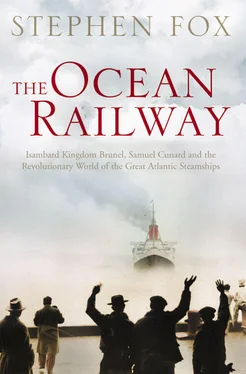Seven days out, they were still not halfway across. ‘I’ll get nervous if we don’t go faster homewards, the only comfort I have is that the ship answers [her rudder] beautifully and is as easy as any slipper, all on board are loud in her praise.’ Even the large complement of paying passengers did not please him. Laird rather disapproved of the ship’s diverse company, which included Englishmen, Americans, Frenchmen, Germans, Spaniards, Portuguese, Russians and Poles, about 120 people in all, eating and jabbering loudly in strange tongues at dinner. Miserable, lonesome, and ever worried about his ship, Laird longed for home and dry land. ‘It being my duty I came, but certainly if I could get my living in any other way, than being connected with these passenger steamers, I would most thankfully do it. I am never well, thoroughly well on board ship – I don’t care for the talk and society of people I care nothing about and who care as little for me.’ In the final days, a more favourable wind helped the ship cruise at eleven knots. The British Queen reached New York after fourteen and a half days, excellent time by sailing standards but twenty-four hours worse than the Great Western’s latest record. ‘The public will look at the time only,’ Laird knew, ‘and not to all the circumstances of the voyage.’
A fairer test came at once, as both Atlantic steamships left New York for home on the first of August. The Great Western carried 59 passengers, the British Queen 103. Sailing at the same time, by similar routes, they encountered essentially identical winds and currents; no differing ‘circumstances’ would console the loser. This first true transatlantic steamship race, between the only two vessels yet designed and built for the North Atlantic trade, was keenly followed on both sides of the ocean. After a head start of forty-five minutes, the Great Western steadily lengthened her lead for most of the voyage. On the last two days, though, the British Queen— still breaking in her machinery – closed the gap rapidly and reached Portsmouth only about two hours after the Great Western came into Bristol on 14 August. The British Queen did set a new elapsed round-trip record of thirty-two days, twelve hours. Engineers from both the Thames and Clyde could find reasons to preen themselves.
Later voyages, however, proved that Smith and Laird had built a larger but slower vessel. ‘ The British Queen wasa fine ship,’ noted Sam Cunard, who was paying close attention, ‘but she had not power sufficient. ’ During the 1839 season, in three round-trips she averaged seventeen days, eight hours to New York and sixteen days, fourteen hours home. (The latter figure was skewed by an extended December voyage, hobbled by machinery breakdowns, of twenty-two days, twelve hours.) The Great Western in six round-trips beat her rival’s averages by twenty hours out and three days, five hours home. With a higher ratio of horsepower to tonnage, she showed more effective power against the wind, better sailing qualities with it, and the durability necessary for regular ocean crossing. ‘ Is it not reasonableto conclude,’ offered a Londoner, ‘that the engineers of the Thames must be vastly superior to those of the Clyde?’
In the entrepreneurial contest over building and managing an Atlantic steamship, brunel and Bristol had beaten Smith and London. In the engineering battle of the rivals for transatlantic engine-building supremacy, the Thames had won the first round. Across this combined arena of enterprise and engineering, Glasgow – the founder and still centre of British steam navigation – had not much to brag about, as yet.
Samuel Cunard had a plan. He characteristically discussed it with nobody outside his family. Only his son Ned, now twenty-three years old and an active partner in the Cunard enterprises, knew what his father was up to. During his annual trips to England, Sam had observed the first efforts at transatlantic steam. Taking their measure, he thought he could do better. In January 1839 he boarded a sailing packet to England and embarked on his greatest gamble. As an outsider, he felt no hobbling allegiance to Bristol or London or Glasgow. Well connected to some British power brokers, yet with no loyalties or commitments to any steam builders, Cunard moved around quietly, asking questions and making judgments. ‘ Altho I ama colonist,’ he later explained, ‘I have many friends in this country.’ The silent colonial attracted little attention; the real transatlantic action seemed to rest in other, more famous hands. Stealthy and independent, he found the right men for his ships and cut the deal of his life. Cunard got his boats built and running – and stole the game away from its earlier players. ‘ The plan wasentirely my own,’ he said later, ‘and the public have had the advantage of it.’
Cunard went to England early in 1839 because the British government had declared its intention to subsidize steam navigation between England and America, not to carry passengers or cargo (except incidentally) but mainly to transport the mail, that most essential tool of commerce and empire. The Great Western, by her five routine round-trip voyages in 1838, had shown the possibilities of regular transatlantic steam. Her performance highlighted the many inadequacies of the British Admiralty’s sail-powered mail boats, the ten-gun brigs that ran monthly and unpredictably between Falmouth and North America. In November 1838, rushing to catch up, the Admiralty invited hasty bids from British contractors to provide a monthly steamer mail service between England and Halifax, stipulating ships of at least 300 horsepower. The bids were due in only a month, and the service was to start by April – a schedule so tight that it restricted the field to existing vessels already built for other purposes.
At the time, the Great Western Steam Ship Company maintained a virtual monopoly on transatlantic steam. It had far outclassed the few competing ships, and Junius Smith’s overdue British Queen would not finally be ready until the following summer. Holding all the cards, the Bristol company proceeded to overplay its hand with the government. On 13 December, two days before the deadline, Christopher Claxton wrote to Charles Wood of the Admiralty that his company was interested but needed much more time. The last voyage of the Great Western, with a slow winter passage of nineteen days to New York, had shown (said Claxton) the need for specially constructed mail ships of 1200 tons and 450 horsepower, slightly smaller but more powerful than the Great Western. Claxton offered to build three such ships within eighteen to twenty-four months, and then to carry the mail once a month in each direction, for £45,000 annually under a seven-year contract.
The government wanted action in four months, not two years. The Great Western company ignored that urgency and rewrote the terms of the tender: in effect, instructing the Admiralty about the realities of steam on the North Atlantic. The company’s correcting tone may have annoyed the Admiralty (which believed it had some knowledge of steamships and oceans), and it compounded an earlier, related offence by Thomas Guppy. In the autumn of 1837, at a scientific meeting in Liverpool, Guppy – a founder and director of the Great Western company – had sharply criticized the Royal Navy’s steamship designs. ‘ Many of the governmentvessels are of very bad forms; their power and size greatly disproportioned, ’ Guppy declared. ‘Whoever had seen the fine private steamers belonging to the ports of London, Liverpool, Glasgow, and Bristol, and had then gone to view the government ones in Woolwich basin, must have been astonished at the extraordinary forms there collected; it would be well if a glass case could be constructed over the basin, to procure those curiosities of practical science, as exercised in our naval building yards.’ (The audience laughed at this sally.) Guppy did not just doubt the government ships; he mocked and made jokes of them. His remarks were published in the Nautical Magazine of London, which was carefully read at the Admiralty. And now his company had doubled the insult by turning the government’s urgent mail tender inside out. The Admiralty, no surprise, rejected the Great Western proposal on 10 January.
Читать дальше












